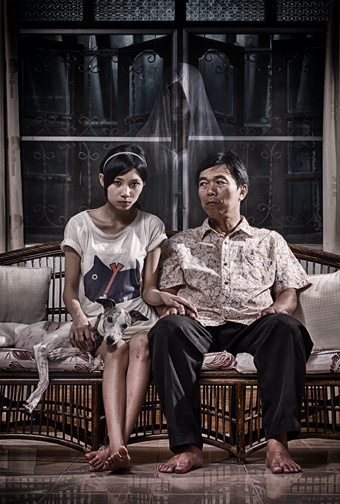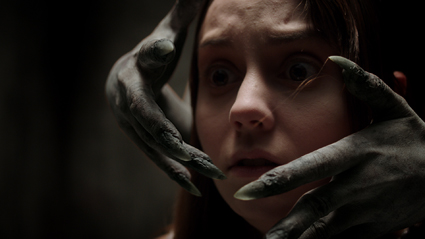Horror—beyond genre
Katerina Sakkas: Stranger With My Face Horror Film Festival

Chanthaly
It was with heady anticipation that I arrived in Hobart for the third annual Stranger With My Face Horror Film Festival. Voted one of the “Top Five Coolest Women’s Film Festivals in the World” by readers of Movie Maker magazine, SWMF was started by Hobart-based filmmakers Briony Kidd and Rebecca Thomson as part of Women in Horror Month, the February-based initiative founded in 2010 by US writer/filmmaker Hannah Neurotica, which aims to highlight female directors working in a heavily male-dominated genre.
SWMF took root after Kidd’s short film, The Room at the Top of the Stairs, was shown in another women’s horror film festival, the LA-based Viscera Film Festival. “That’s all I wanted to do initially in 2012, just screen some of the Viscera shorts as a Women in Horror Month event in Hobart. But there were other films that I wanted to include as well, and then we wanted to have talks and a script comp, and it very quickly became its own thing. So we ran with it and called it Stranger With My Face (after the Lois Duncan YA novel) because the kind of horror I’m most interested in as the programmer of the festival concerns the ‘horror within’ rather than your more straightforward external threat.”
This year’s four-day program boasted five feature films, Australian and international shorts programs, children’s workshops, a symposium, exhibitions, play readings and the popular 48-Hour Tasploitation Challenge—a short film competition open to all. It opened officially with Ann Turner’s 1988 feature Celia.
Celia is a remarkable evocation of an Australian childhood whose terrors, enmities and fantasies transform, in response to 1950s political paranoia, into something jagged and dangerous. Child star Rebecca Smart’s unaffected yet compelling presence in the title role is supported by an accomplished cast and Geoffrey Simpson’s expansive cinematography. Chris Neal’s chiming score contributes strongly to the sense of an eerie childhood netherworld. The film’s detours into fantastic surrealism, gradually dovetailing with moments of real-world violence, led Kidd in her introduction to name Celia as a precursor to Peter Jackson’s Heavenly Creatures (1994).
Opening a horror film festival with a ‘non-horror’ film, albeit one with horror elements, might be unconventional, but the decision to spotlight this lesser-known classic proved astute, for Celia introduced significant themes that resonated in the festival films to follow: unflinching identification with a female protagonist; retreat into a mythic woodland world in which (often violent) empowerment is found; and the conflicted identity suggested by SWMF’s title.
Running alongside the film program was the Mary Shelley Symposium, taking in traditional fairytales, Tasmanian Gothic, the children’s bogeyman in contemporary cinema and an illuminating history of women in horror. Common themes snaked their way through symposium and film program. Says Kidd, “The two are programmed side by side, but I wanted it to feel like they were riffing off each other in various ways. For example, Emily Bullock talked about Tasmanian Gothic and The Tale of Ruby Rose (1989) and we screened the short film Little Lamb, which is a new example of Tasmanian Gothic and the director’s mentor in making it was Roger Scholes, the director of Ruby Rose. I also realised there was a fairytale element to a lot of the films I was considering…so adopted that as an informal theme across the program.”
The Australian shorts program ranged from gorily irreverent to haunting and melancholic. Splatter gags were plentiful in Mia’Kate Russell’s queer werewolf farce Swallow (2013) and Caitlin Koller’s Maid of Horror (2013), which sees a bridesmaid usurping her friend’s big day in the bloodiest possible way. In contrast, Victoria Thaine’s The Kingdom of Doug (2013) was elegantly sparse, its subdued mood enhancing the cultish horror at its centre. Little Lamb (2014) gave us a convict-era Bluebeard with Tasmania’s dark rural landscape as grim backdrop.
International shorts were similarly eclectic. Grace Under Pressure (Jen Moss, UK, 2014) presented a cheeky spin on the wish-granting fable, while conversely, Hide and Seek (Kayoko Asakura, Japan, 2013) moved with beautiful clarity of composition from calm through to suspense, terror and ultimately horror. The standout was Substance (USA, 2014), Barbara Stepansky’s immersive, hallucinogenic account of two friends unwittingly bringing an alien powder to a winter music festival.

Evangeline, Karen Lam
The intense identification with a female protagonist—even beyond death—found radical expression in the festival’s ‘victim narratives’: feature films Evangeline (Karen Lam, 2013) and Kept (Maki Mizui, 2014). Partially inspired by a long series of unsolved murders of young women in British Columbia, Evangeline begins with its titular heroine (Kat de Lieva) escaping a restrictive upbringing for the excitement of college life. Lam develops this part of the narrative as though it’s a gentle coming-of-age film, allowing Evangeline to blossom as a character before, in a brutal turn of the tables, she is violently assaulted by young men she trusted and left for dead in the woods. The film now enters a subterranean world of heightened violence where fantasy and reality combine to hammer home the heroine’s suffering and rage.
Kept is, most disturbingly, based on its director’s personal experience of an abduction—faithfully reproduced, according to a Skype interview post-screening, in the film. Her attacker would subsequently go on to violently rape another young woman. Dealing with Mizui’s guilt at not reporting her attack sooner, Kept is the most difficult SWMF film to watch. Its bald detailing of sexual violence is unflinching, though the main character’s retreat into animist woodland fantasy offers some respite. It is hard not to be reminded, while watching Kept and Evangeline, how completely they upend conventional crime/horror narratives where an unformed female character is raped or murdered purely to drive the plot and further the character development of an often male protagonist and his antagonist. In Lam and Mizui’s scenarios, the viewer must remain with the victim; there is no escape from the suffering she endures, nor its consequences. The closest relative to these depictions might be the rape revenge movie, but Evangeline and Kept are deeply personal; far less formulaic.
Ground-breaking too, for different reasons, was SWMF’s closing film Chanthaly (2012), Laos’ first horror film and its first from a female director, Mattie Do. Made, astoundingly, for under $5000 and shot entirely in Do’s home, Chanthaly’s limitations work to its advantage, painting a claustrophobic picture of a young woman’s sheltered life in middle class Vientiane. The supernatural makes its presence felt ominously yet quietly. Do’s discussion afterwards with Indonesian-Australian filmmaker Katrina Irawati Graham covered the pressures and pitfalls of making a horror film in Laos, ranging from being arrested (due to Do’s recent emigration from the US) to having to justify to government officials the inclusion of scenes depicting hand-holding and a female lead wearing pyjamas.
This exploration of different perspectives and shaking up of familiar narratives is something that horror, a naturally transgressive genre, can pursue to great effect, but often does not. That SWMF showcases films outside of horror’s ‘safe zone’ makes it genuinely exciting. As Briony Kidd explains, “I’m looking for films that have something to say. There’s an assumption that genre is mainly escapism but, to me, there’s so much scope in horror to be provocative or extreme or personal or original, so why wouldn’t you take advantage of that?”
Stranger With My Face Horror Film Festival, University of Tasmania, Art School and Salamanca Arts Centre, Hobart, 21-24 Aug
RealTime issue #123 Oct-Nov 2014 pg. 18






